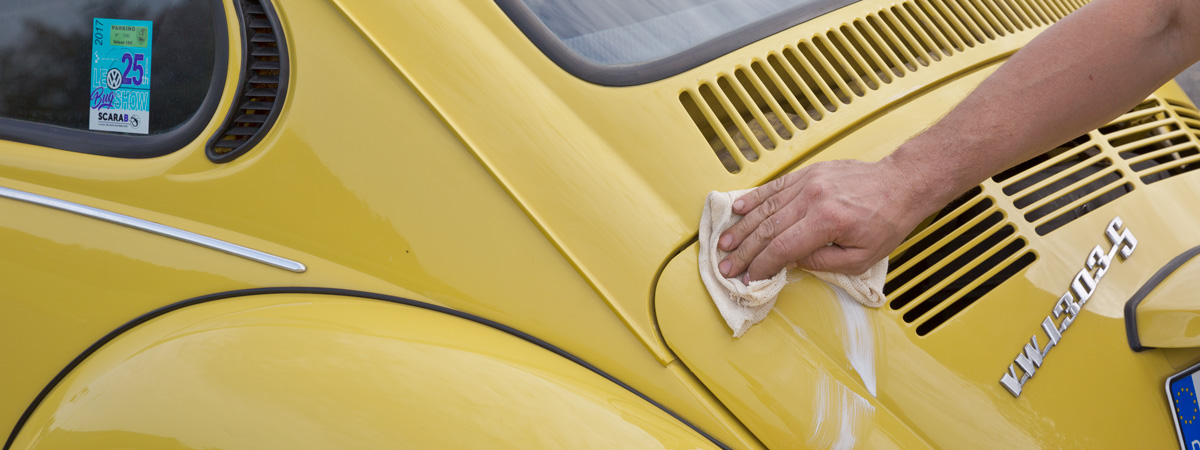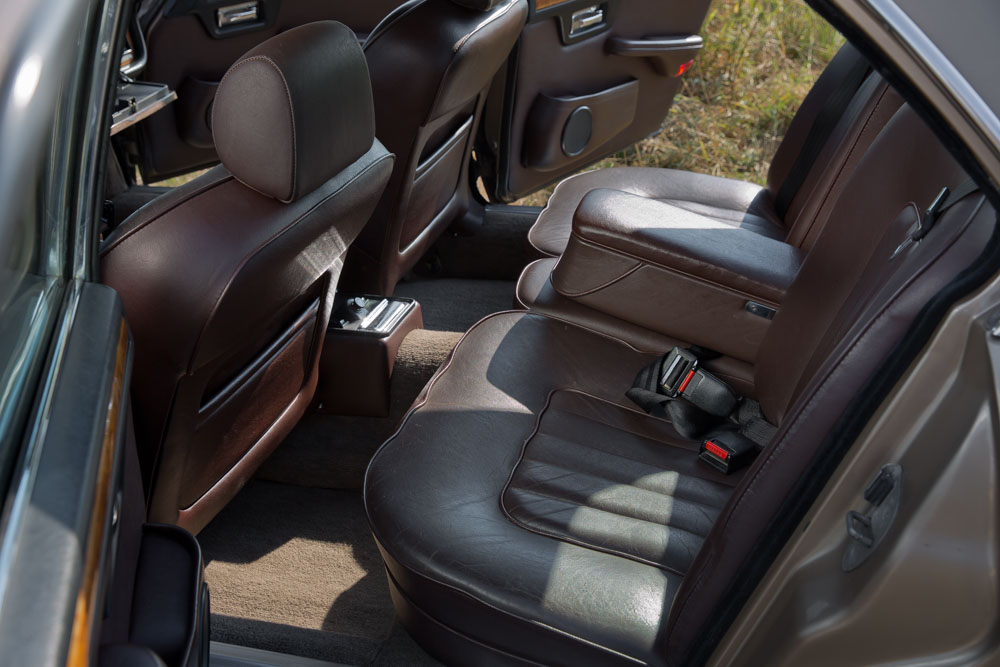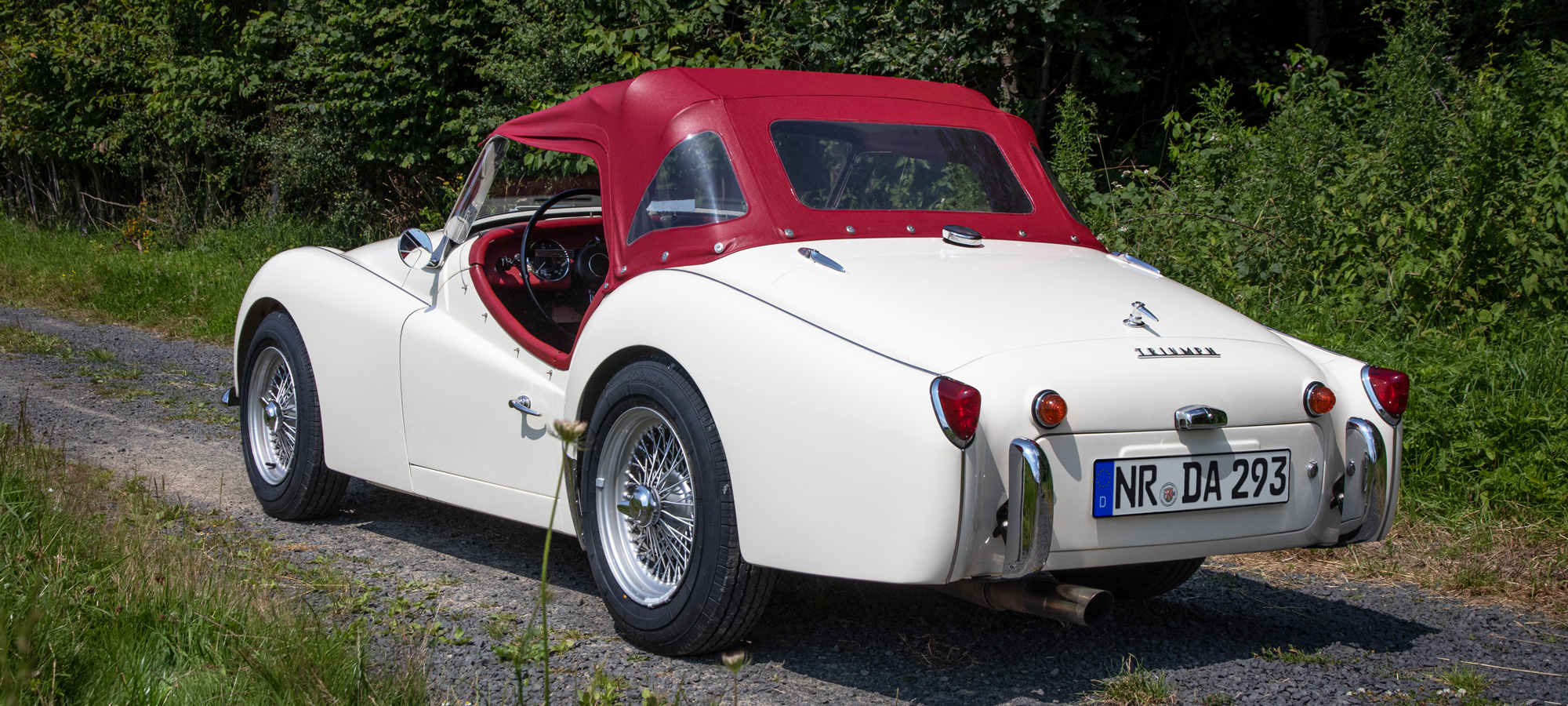Professional classic car maintenance with no risk
Shiny paintwork, chrome that really sparkles in the sun, soft, well-kept leather and a cockpit that invites you to drive off - that's how a classic car should look at best. To ensure that your collector's car really shines, you should definitely rely on regular and, above all, professional classic car maintenance. The professionals at Limora will tell you what to look out for!

Auteur : Dylan Smid
Poste : Ventes
Mise à jour : 25.10.2023

General classic car care tips
A true classic has at least
already 30 years under its belt. Usually even more. But it should
you shouldn't look at him. Before we dwell on the care of the
individual components, materials and surfaces, we have
here are general classic car care tips
compiled. This is how you protect your classic car and save yourself
not only time, but also money.
- Wash your classic by hand and avoid car washes.
- Use Only use high-quality cleaning products.
- Note Always refer to the manufacturer's instructions for use when using cleaners work.
- Saving Do not use auxiliaries for vehicle care, like Sponges and microfiber cloths are also better used here quality products, do not use with household sponges and the like.
- Use Use extreme caution when using acidic rim cleaners. These Cleaners are only suitable for painted alloy wheels.
- Avoid You pressure washer. When it's time need to go fast, keep enough Distance. At least 40 cm!
- Parking and do not clean your vehicle in the blazing sun.
- Parking your vehicle in a sheltered garage.
- Covers you also cover your car with a car cover, even if it's in a garage.
- Invest into a paint coating measuring device, if you like to polish yourself and also have experience with it. So play it safe with any machine polish and detect thin layers of paint before doing any damage.
Now that you know what it is at the
to avoid classic car care, we can tell you how
it goes right.
Body: maintain and clean classic car paint
This is where the classic car care fun begins: namely with a thorough washing of the body, am best in manual work. Please note that many municipalities prohibit vehicle washing in the front yard. we recommend in such cases to visit suitable washing places.
What you need for perfect paintwork care
and need cleaning?
- two Bucket,
- one soft sponge or a wash mitt
- a leather or microfiber cloth for buffing,
- a car shampoo
- and water
The cleaner goes in bucket number one, only clear water in the second bucket to wash out the sponge. In this way, the dirt is thoroughly rinsed out and you don't run the risk of causing scratches with the dirty sponge. As with all classic car care, work with little pressure and plenty of washing water and clean the vehicle from top to bottom. Proceed with millimeter work, because this way you can also identify any damage that you should have repaired if necessary.
The cleaning foam can then be sprayed off with a garden hose without a nozzle attachment, i.e. with a soft jet and lots of water. After rinsing, the classic is ideally leathered off lovingly. Then dry with a leather or microfiber cloth so that the paint really shines. Wax, for example carnauba wax, can be used as a seal at the end.
This is also a good idea for the window panes: For the outside, we recommend sealing the panes that protects against rain and dirt.
Important: Do not drive your classic vehicle into the car wash. Today's washing systems work with such high water pressure that the vehicle is damaged or takes up a lot of water in places that would not get wet during normal use. Rain, on the other hand, hits your car without pressure! A 1950's car could go into a 1950's car wash. But not in one of today.
- In coupes, the washing water runs through the window seals.
- The doors of all vehicle types are full.
- Cabriolets only started being car wash-proof in the 1990s.
- Large amounts of water run into the vehicle through top-hung windows, triangular windows and folding roofs.
- Luca's electrical system is often sensitive to large amounts of moisture. In many cases, the car will no longer start after being washed in a modern car wash.
Important: Always ensure good drying so that no moisture can collect in cavities or cracks, causing rusting. After rinsing, don't forget to buff off thoroughly!
The right care for tires and rims
At the same time you also take care of tires and rims. Depending on whether you have aluminum or steel rims, proceed as follows:
- With steel rims, you can use the high-pressure cleaner and use it to remove stubborn dirt Soak for a few minutes. Then wipe everything clean with a cloth and that's it.
- For aluminum rims, use a high-pressure cleaner and a special Cleaning agent for aluminum rims. Above all, burnt-in brake dust becomes a challenge here.
Caution: We advise against home remedies such as oven spray, that which is often recommended for cleaning, since the acid it contains can damage the rim paint. It is better to use more force and use cleaners without acid! An effective (albeit very strenuous) household remedy for cleaning heavily soiled aluminum rims is polishing with a coarse polish, e.g. chrome polish.

Special topic engine wash
Important: Car washes are almost everywhere, including many public ones washing places, forbidden. It is necessary when looking for an oil leak, for example. Performed with the steam jet it is unnecessary and harmful on all other occasions. Regular cleaning with mild water and a soft sponge also keeps the engine compartment sufficiently attractive.
Washing the engine on a motorcycle is also difficult. High-pressure cleaners also displace grease in places that cannot be easily relubricated, for example swingarm and steering head bearings.
Care for the interior, windows and plastic of classic cars
Then you use a vacuum cleaner in every little crack and prepare the interior perfectly for the subsequent cleaning and care. Ideally, you should use the vacuum cleaner and its various attachments at the very beginning and then again at the end of the interior cleaning as a finish.
Interior care is about the heart of every vehicle, the cockpit. A lot happens in the vehicle interior. Therefore, the dashboard should be well cared for so that it is in no way inferior to the paint in terms of gloss. Mats and faded areas can be tackled with special plastic cleaners and care products, bringing them back to life Shine. The same applies to center console and door panels.
When cleaning the interior, don't forget the seat belts. Simply wipe over it with a slightly damp cloth and optionally use a fabric cleaner. You can also check whether the seat belts are still in good condition! And if bad smells have formed in the car, which unfortunately often happens with classic cars. First look for the causes of the smell. After eliminating the cause, you can eliminate the odor with a odor eliminator.
Finally, you take the window cleaning to hand: windshield, rear window and the windows in the front and in the back seat should be made to shine from the inside, for example Example using a chamois leather. A car window interior cleaner with a telescopic handle can help. As a finish, you can also apply a sealant to keep the shine for a long time. Simply apply this with a soft sponge and then polish off.
Caution: Regular glass cleaners for domestic use are not suitable for car windows because they attack the rubber seals! Better to use special window cleaner for cars. Stubborn dirt can also be removed with a chrome polish.
Bad smell in the car - reasons for and remedies against it
Check out our Youtube Channel for more information on reasons for bad smell in classic cars and possible remedies!
Leather care for classic cars
Leather in the car is not only visually appealing, it is also a popular cover for seats, steering wheel or gear stick due to its material properties.
These components are also frequently touched in the vehicle. Since leather is made up of fat, liquid and dyes in addition to skin and tanning agents, it must be particularly carefully cared for and re-greased. The consequences of not doing this are dry, brittle areas that, in the worst case, even tear.

Older leather in particular needs a care unit up to twice a year. You're welcome to lend a hand every three months with light-colored leather, because color residues from clothing and environmental influences such as fine dust are particularly visible here.
For convertibles, care products with a UV filter are also a good idea, as they protect the seats and other leather components from fading. When it comes to care and cleaning products, the motto always applies: less is more. For example, too much fat can leave behind ugly white edges. In addition to the quality, you should also pay attention to the type of care product when choosing a product, because there are separate products for shiny and matt leather.
When cleaning, first remove coarse dirt with a cloth or a vacuum cleaner. You should work your way from seam to seam and always in one direction. In this way, particularly light-colored seams can be protected from discoloration and dark ones also retain their shine. Clean the surfaces with as little moisture as possible and allow the components to dry thoroughly. The best way to do this is to use a microfiber cloth and carefully dab the leather dry.
Rubber care for classic cars
Rubber care should not be neglected when caring for classic cars. Well maintained seals on doors and windows have a long service life if they are protected from drying out. The rubber parts can be cleaned with warm water and a soft cloth. Then you dry everything well and apply a thin layer of care product. There are many care products:
- Glycerin,
- Silicone (use very sparingly)
- Vaseline,
- deer tallow,
- talc are the ones most common.
Products containing oil should be used with caution, as they can dissolve the rubber seals over time. Home remedies should also be avoided. Special care products are always the safe choice when it comes to your collector's vehicle. And if the seals are already porous, there is only one thing left to do: get rid of them and install new seals.
The floor mats that you put aside at the beginning of the cleaning tour can be easily cleaned with a mild soap and a soft brush. Stubborn dirt can also be soaked in a water bath with a little soap for a while.
Metal care for the classic
With moving metal parts, it is important to clean them regularly and then treat them with special care oils or graphite spray. These include:
- Hinges (on the convertible top, doors and bonnet)
- Locks
For all other metal and decorative parts made of aluminum, brass, stainless steel or chrome, there are highly effective special products for cleaning and care. However, these should always be tested in an inconspicuous place and checked for compatibility. A car wax can then be applied to seal and protect against new dirt.
With chrome vehicle components, exercise caution, because if chrome layers come loose, they can quickly be completely destroyed. Chromed components cannot be saved. If you find a company that rechromes classic car parts, you are very lucky. In the worst case it is necessary to replace the parts with new parts.
So that the thin chrome plating is not "polished through", you should always work with little pressure and use mild paint polishes. This grinds less than standard metal polish, which is often recommended. A clean microfiber or cotton cloth is suitable for application, with which you can apply the polish with gentle, circular movements after cleaning. Then also seal with a Car paint hard wax so that the polish is not immediately gone.
Clean convertible tops
You should be particularly careful here and only work with the right cleaning agent if no suitable cleaning agent is available use a mild shampoo. There are special green growth removers for removing green growth and algae. This also applies to the cleaning of vinyl and fabric hoods, for which we have already written our own guide.
It is important that fabric tops in particular are dried well after cleaning. You can use large towels for this and put them on until they have drawn the moisture out of the fabric. Extreme caution when using impregnation solutions.
- Check the material the convertible top is made of. Check with the work instructions whether you can impregnate the material.
- Top skins made of PVC must never be impregnated.
- Top skins made of multi-layered Sonnenland fabrics tend to delaminate when incorrectly dosed, which is indicated by bubbles under the top layer of fabric.
- Before impregnating, use a lint remover to free the roof of anything that could impede the impregnation.
Caution: When impregnating windows, front and rear windows be sure to mask it off! The protection attacks namely species-distant materials.

Triumph TR3A Convertible
Care for technical components and operating materials in classic cars
Regular oil changes in classic cars are very important, especially when it comes to the Oldtimer storage in winter. The choice of oil can have a positive effect on performance when operating the vehicle. Oils that have been specially developed and adapted for the technical requirements of classic vehicles are most suitable.
Brakes and other safety-relevant parts such as headlights and tires must not be neglected here either. It is best to check these at regular intervals so that no danger can arise.
Regular lubrication should also be part of every classic car owner's basic care routine. In addition, professional underbody sealing once a year is a guarantee of a well-maintained vehicle. You should not save money here, even if it can cost a lot of money.
Classic car care is a must for every owner
If you want to protect your collector's vehicle from dirt, mold, rust and fading, don't perish regular classic car care around. You have read here how best to proceed. You can imagine where you can get high-quality care and cleaning products. Exactly! With the professionals from Limora. Because we get what moves.